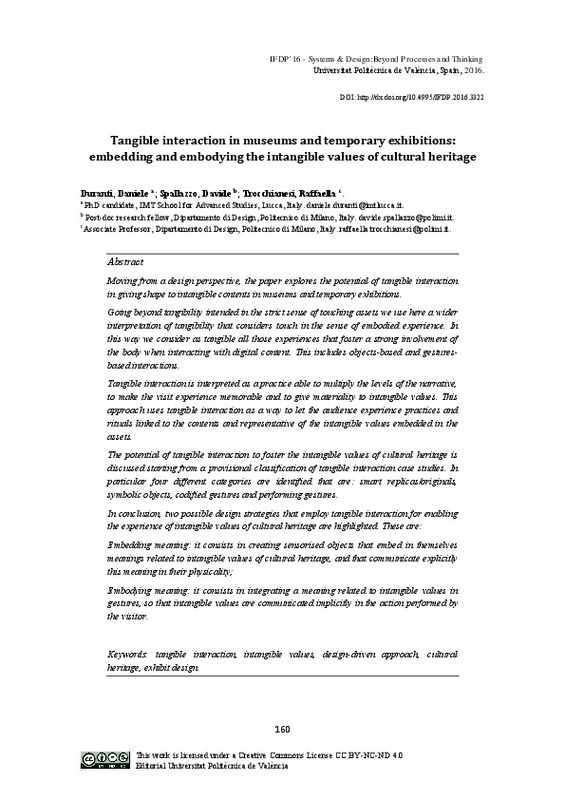JavaScript is disabled for your browser. Some features of this site may not work without it.
Buscar en RiuNet
Listar
Mi cuenta
Estadísticas
Ayuda RiuNet
Admin. UPV
Tangible interaction in museums and temporary exhibitions: embedding and embodying the intangible values of cultural heritage
Mostrar el registro sencillo del ítem
Ficheros en el ítem
| dc.contributor.author | Duranti, Daniele
|
es_ES |
| dc.contributor.author | Spallazzo, Davide
|
es_ES |
| dc.contributor.author | Trocchianesi, Raffaella
|
es_ES |
| dc.date.accessioned | 2017-09-22T07:44:46Z | |
| dc.date.available | 2017-09-22T07:44:46Z | |
| dc.date.issued | 2016-10-27 | |
| dc.identifier.isbn | 9788490484401 | |
| dc.identifier.uri | http://hdl.handle.net/10251/87813 | |
| dc.description.abstract | [EN] Moving from a design perspective, the paper explores the potential of tangible interaction in giving shape to intangible contents in museums and temporary exhibitions. Going beyond tangibility intended in the strict sense of touching assets we use here a wider interpretation of tangibility that considers touch in the sense of embodied experience. In this way we consider as tangible all those experiences that foster a strong involvement of the body when interacting with digital content. This includes objects-based and gesturesbased interactions. Tangible interaction is interpreted as a practice able to multiply the levels of the narrative, to make the visit experience memorable and to give materiality to intangible values. This approach uses tangible interaction as a way to let the audience experience practices and rituals linked to the contents and representative of the intangible values embedded in the assets. The potential of tangible interaction to foster the intangible values of cultural heritage is discussed starting from a provisional classification of tangible interaction case studies. In particular four different categories are identified that are: smart replicas/originals, symbolic objects, codified gestures and performing gestures. In conclusion, two possible design strategies that employ tangible interaction for enabling the experience of intangible values of cultural heritage are highlighted. These are: Embedding meaning: it consists in creating sensorised objects that embed in themselves meanings related to intangible values of cultural heritage, and that communicate explicitly this meaning in their physicality; Embodying meaning: it consists in integrating a meaning related to intangible values in gestures, so that intangible values are communicated implicitly in the action performed by the visitor. | es_ES |
| dc.format.extent | 12 | es_ES |
| dc.language | Inglés | es_ES |
| dc.publisher | Editorial Universitat Politècnica de València | es_ES |
| dc.relation.ispartof | Systems&design:beyond processes and thinking | es_ES |
| dc.rights | Reconocimiento - No comercial - Sin obra derivada (by-nc-nd) | es_ES |
| dc.subject | Tangible interaction | es_ES |
| dc.subject | Intangible values | es_ES |
| dc.subject | Design driven approach | es_ES |
| dc.subject | Cultural heritage | es_ES |
| dc.subject | Exhibit design | es_ES |
| dc.title | Tangible interaction in museums and temporary exhibitions: embedding and embodying the intangible values of cultural heritage | es_ES |
| dc.type | Capítulo de libro | es_ES |
| dc.type | Comunicación en congreso | es_ES |
| dc.identifier.doi | 10.4995/IFDP.2015.3322 | |
| dc.rights.accessRights | Abierto | es_ES |
| dc.description.bibliographicCitation | Duranti, D.; Spallazzo, D.; Trocchianesi, R. (2016). Tangible interaction in museums and temporary exhibitions: embedding and embodying the intangible values of cultural heritage. En Systems&design:beyond processes and thinking. Editorial Universitat Politècnica de València. 160-171. https://doi.org/10.4995/IFDP.2015.3322 | es_ES |
| dc.description.accrualMethod | OCS | es_ES |
| dc.relation.conferencename | Systems & Design: Beyond Processes and Thinking | es_ES |
| dc.relation.conferencedate | June 22-24,2016 | es_ES |
| dc.relation.conferenceplace | Valencia, Spain | es_ES |
| dc.relation.publisherversion | http://ocs.editorial.upv.es/index.php/IFDP/IFDP/paper/view/3322 | es_ES |
| dc.description.upvformatpinicio | 160 | es_ES |
| dc.description.upvformatpfin | 171 | es_ES |
| dc.type.version | info:eu-repo/semantics/publishedVersion | es_ES |
| dc.relation.pasarela | OCS\3322 | es_ES |








